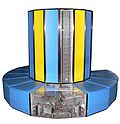The Cray XC30 is a massively parallel multiprocessor supercomputer manufactured by Cray. It consists of Intel Xeon processors, with optional Nvidia Tesla or Xeon Phi accelerators, connected together by Cray's proprietary "Aries" interconnect, stored in air-cooled or liquid-cooled cabinets. [1] Each liquid-cooled cabinet can contain up to 48 blades, [2] each with eight CPU sockets, and uses 90 kW of power. [3] The XC series supercomputers are available with the Cray DataWarp applications I/O accelerator technology. [4]
Contents
In 2014, the Cray XC30 systems appear prominently on the TOP500 supercomputer lists. [5]
